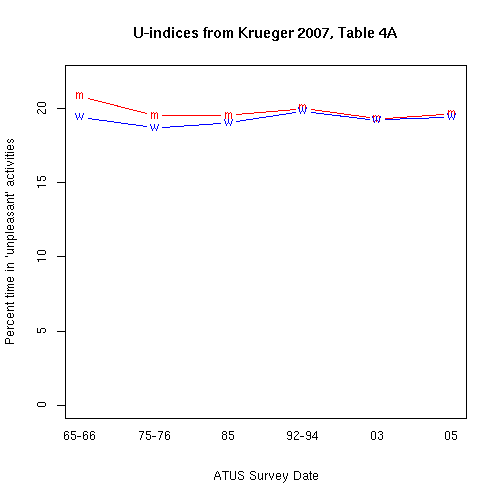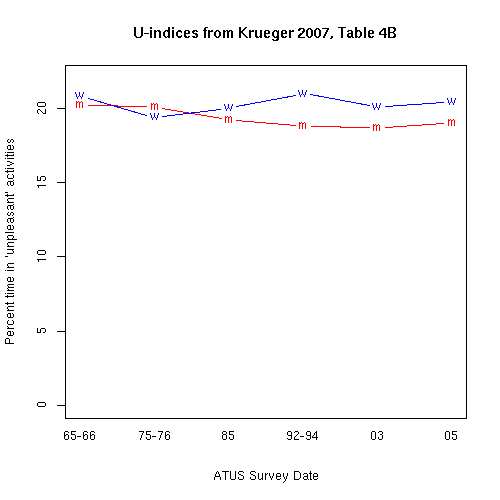October 01, 2007
Why are economists so misleading?
The "happiness gap" coverage continues over at the NYT, where today's Freakonomics blog picks it up ("Why are women so unhappy?", 10/1/2007), and hundreds of readers are once again pouring out their souls in the comments.
But the real question here is not why women are so unhappy, but why economists (and journalists) are so prone to oversell tiny group differences as if they were universal characteristics of the individual group members. Steven D. Levitt answers that implicit question in his lead sentence:
I saw Justin Wolfers a few weeks back, and I joked with him that it had been months since I'd seen his research in the headlines.
There's a parallel question, "Why is the public so gullible?", but the answer to that one has been well understood since the seminal research of Barnum (1869). Overall, the "happiness gap" coverage is a wonderful case study of the role that science journalism has come to have in public discourse.
In a couple of earlier posts, I took at quick look at the U.S. General Social Survey data from the unpublished Stevenson and Wolfers paper "The Paradox of Declining Female Happiness", and concluded that the "happiness gap" is pretty underwhelming, despite the deep chord that the news has obviously struck in the public consciousness. The "gap" doesn't show up in any single year's survey data -- indeed, both in 1972 and 2006, a somewhat larger fraction of women than of men reported themselves to be "very happy". The "gap" and can only be seen through the magnifying-glass of a powerful statistical analysis across 34 years, which turns up a trend that is small relative to the year-to-year fluctuations, and tiny relative to the within-group happiness variation estimated by the model (which suggests that the between-group difference in happiness is about 1.9 percentile points).
Last week, I failed in my search for the other unpublished paper, Alan Krueger's work on trends in sex differences in the amount of time spent on activity perceived as unpleasant. So I fell back on some general observations about how the poor test/retest correlations of such judgments suggest that his group differences in misery indices are also likely to be extremely small in percentile terms.
But this afternoon, thanks to a tip from Matt Henning, I found Alan B. Krueger, "Are We Having More Fun Yet? Categorizing and Evaluating Changes in Time Allocation", draft version of 8/23/2007. Unfortunately, Prof. Krueger doesn't give us any information about the within-group (or even overall) distribution of his misery index. However, he does provide the table of time-series data that the NYT writer (David Leonhardt) called "an even starker pattern". Here it is -- I've plotted the data from his Table 4A "U-Index from Men and Women Combined". (Men's data is plotted with red 'm' letters, women's data with blue 'w' letters.)

Now, how many of you really think that the question to ask about this graph is "Why Are Women So Unhappy?", as opposed to the other two questions that I asked at the start of this post?
In Table 4B, Krueger massages the data a bit differently, using sex-specific estimates of activity unpleasantness rather than estimated from pooled evaluations, and comes up with slightly different time functions:

In both time-series, I continue to speculate that the within-group standard deviation of the underlying time-allocation data will be a substantial fraction of the mean values; when I have time, I'll check this out in the ATUS microdata, which is available here. But whatever the effect size, I leave it to you to judge how "stark" this trend in mean values really is.
The real effect here, I think, is the public's hunger for "scientific" evidence about sex roles, as a basis for releasing pent-up negative emotions about personal relationships and social status anxiety. The feelings are real, and worth discussing. The "happiness gap" is not, as far as I can tell, at least not on the basis of what the economists have to tell us so far.
[Update -- Mark Thoma at Economist's View complains that Alan Krueger described the effect as a "gradual" one percent change, and that the "even starker pattern" phrase was due to the journalist David Leonhardt. That's fair enough -- I've neglected my usual rule, which is "When in doubt, blame the journalist".
I spread a bit of the blame on the economists in this case as well, however, because I made the (perhaps unwarranted) assumption that Leonhardt learned about these two pieces of unpublished work because the authors took the initiative to tell him about it, and that his spin on it came from them. And Steven Levitt, who is a member of the clan, seems to like Leonhardt's interpretation just fine.
In any event, of course I don't believe that economists as a group are misleading -- the point of my headline was to make fun of the Freakonomics headline, which asked the a similarly global "why" question about women's alleged unhappiness.]
[More here.]
Posted by Mark Liberman at October 1, 2007 05:36 PM